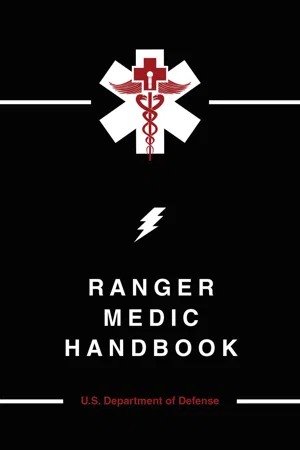![]()
SECTION THREE
RMED PHARMACOLOGY
SECTION I
“PROFICIENT AND ALWAYS CARRIED”
![]()
PHARMACOLOGY SECTION I: “PROFICIENT AND ALWAYS CARRIED”
| 1. | ACETAMINOPHEN (TYLENOL) | 325-650 mg PO q4-6h prn (max: 4 g/d) |
| 2. | DEXAMETHASONE | 0.25–4 mg PO bid-qid; 8–16 mg IM/IV q1–3wks |
| 3. | DIAZEPAM (VALIUM) | 2-10 mg PO tid-qid; 5-10 mg slow IV push |
| 4. | DIPHENHYDRAMINE (BENADRYL) | 25-50 mg IV/IM/PO q4-6h |
| 5. | EPINEPHRINE | 0.1–0.5 mL SC/IM q10–15min (1:1000 soln = 1mg/1ml) |
| 6. | ERTAPENEM (INVANZ) | 1g IV/IM q24h |
| 7. | FENTANYL ORAL LOZENGES (ACTIQ) | 400-800 mcg (max: 1600 mcg/d) |
| 8. | GATIFLOXACIN (TEQUIN) | 400 mg IV/PO daily |
| 9. | HETASTARCH (HEXTEND) | 500–1000 mL IV |
| 10. | IBUPROFEN (MOTRIN, ADVIL) | 400–800 mg PO tid-qid (max: 3200 mg/d) |
| 11. | KETOROLAC (TORADOL) | 15-30 mg IV/IM q6h |
| 12. | LIDOCAINE (XYLOCAINE) | Infiltration 0.5%–2% injection |
| 13. | MELOXICAM (MOBIC) | 7.5–15 mg PO daily |
| 14. | MORPHINE SULFATE (MSO4) | 5–15mg slow IV push, titrate to pain |
| 15. | MOXIFLOXACIN (AVELOX) | 400 mg PO/IV daily |
| 16. | NALOXONE (NARCAN) | 0.4–2.0 mg IV, repeat q2–3min up to 10 mg prn |
| 17. | PROMETHAZINE (PHENERGAN) | 12.5-25 mg PO/IM/IV q4-6h prn |
| 18. | SODIUM CHLORIDE, 0.9% (NS) | 500–1000 mL IV; 5-50 mL IV for med dilution or flush |
1. ACETAMINOPHEN (TYLENOL)
Class: CNS agent – non-narcotic, analgesic, antipyretic
Action: Analgesia action possibly through peripheral nervous system; fever reduction through direct action on hypothalamus heat-regulating center resulting in peripheral vasodilation, sweating, and dissipation of heat; has minimal effect on platelet aggregation, bleeding time, and gastric bleeding
Dose: 325–650 mg PO q4–6h (max: 4 g/d)
Indications: For mild to moderate pain management, headache, fever reduction
Contraindications: Acetaminophen hypersensitivity; use with alcohol; pregnancy category B
Adverse Effects: Negligible with recommended dose; rash; acute poisoning: anorexia, nausea, vomiting, dizziness, lethargy, diaphoresis, chills, epigastric or abdominal pain, diarrhea; hepatotoxicity: elevation of liver function tests; hypoglycemia, hepatic coma, acute renal failure; chronic ingestion: neutropenia, pancytopenia, leukopenia, thrombocytopenic purpura, renal damage
Interactions: Cholestyramine may decrease absorption; barbiturates, carbamazepine, phenytoin, rifampin, and excessive alcohol use may increase potential for hepatotoxicity
2. DEXAMETHASONE
Class: Hormones and synthetic substitutes – steroid; adrenocorticoid; glucocorticoid
Action: Long-acting synthetic adrenocorticoid with intense glucocorticoid activity and minimal mineralocorticoid activity; Antiinflammatory and immunosuppression properties; prevents accumulation of inflammatory cells at sites of infection; inhibits phagocytosis, lysosomal enzyme release, and synthesis of selected chemical mediators of inflammation; reduces capillary dilation and permeability
Dose: 0.25–4 mg PO bid-qid; 8–16 mg IM/IV q1–3wks
Indications: For inflammatory conditions, allergic states, and cerebral edema
Contraindications: Systemic fungal infection, acute infections, tuberculosis, vaccinia, varicella, live virus vaccines (to patient, family members), amebiasis; pregnancy category C
Adverse Effects: Euphoria, insomnia, convulsions, increased ICP, vertigo, headache, psychic disturbances; CHF, hypertension, edema; hyperglycemia; cushingoid state; hirsutism; cataracts, increased IOP, glaucoma, exophthalmos; peptic ulcer or perforation, abdominal distension, nausea, increased appetite, heartburn, dyspepsia, pancreatitis, bowel perforation, oral candidiasis; muscle weakness, loss of muscle mass, vertebral compression fracture, pathologic fracture of long bones, tendon rupture; acne, impaired wound healing, petechiae, ecchymoses, diaphoresis, dermatitis, hypo- or hyperpigmentation, skin atrophy
Interactions: May inhibit antibody response to vaccines and toxoids
3. DIAZEPAM (VALIUM) - CONTROLLED SUBSTANCE: SCHEDULE IV
Class: CNS agent – benzodiazepine; anticonvulsant; anxiolytic
Action: Anticonvulsant and antianxiety psychotherapeutic drug with action at both limbic and subcortical levels of CNS; increases total sleep time, but shortens REM and stage 4 sleep
Dose: 2-10 mg po tid-qid; 5-10 mg slow IV push, repeat in 3-4h
Indications: For anxiety, seizures, skeletal muscle spasm relief; also used as an amnesic, for treatment of restless leg syndrome, acute alcohol withdrawal, and is the drug of choice for status epilepticus Contraindications: Shock, coma, alcohol intoxication, depressed vital signs; acute narrow-angle glaucoma, untreated open-angle glaucoma; MAOIs; pregnancy category D
Adverse Effects: Throat and chest pain; drowsiness, fatigue, ataxia, confusion, paradoxic rage, dizziness, vertigo, amnesia, vivid dreams, headache, slurred speech, tremor; EEG changes, tardive dyskinesia; hypotension, tachycardia, edema, cardiovascular collapse; blurred vision, diplopia, nystagmus; xerostomia, nausea, constipation, hepatic dysfunction; incontinence, urinary retention, gynecomastia (prolonged use); hiccups, coughing, laryngospasm; venous thrombosis, phlebitis
Interactions: Alcohol, CNS depressants, anticonvulsants, and herbals (kava kava, valerian) potentiate CNS depression; cimetidine increases levels and toxicity; may decrease effects of levodopa; may increase phenytoin levels; smoking decreases sedative and antianxiety effects
4. DIPHENHYDRAMINE (BENADRYL)
Class: ENT agent – H1-blocker; antihistamine
Action: H1-receptor antagonist and antihistamine as it competes for H1-receptor sites on effector cells; significant central anticholinergic activity as it prolongs action of dopamine by inhibiting its reuptake and storage, thus decreasing parkinsonism and drug-induced extrapyramidal symptoms
Dose: 25-50 mg IV/IM/PO q4-6h
Indications: For allergic conditions, treatment or prevention of motion sickness, vertigo, blood or plasma reactions, treatment of Parkinsonism and drug-induced extrapyramidal reactions; also used with epinephrine for anaphylaxis, as a cough suppressant, a sedative-hypnotic, and for intractable insomnia Contraindications: Antihistamine hypersensitivity; lower respiratory tract symptoms, asthma; n...
